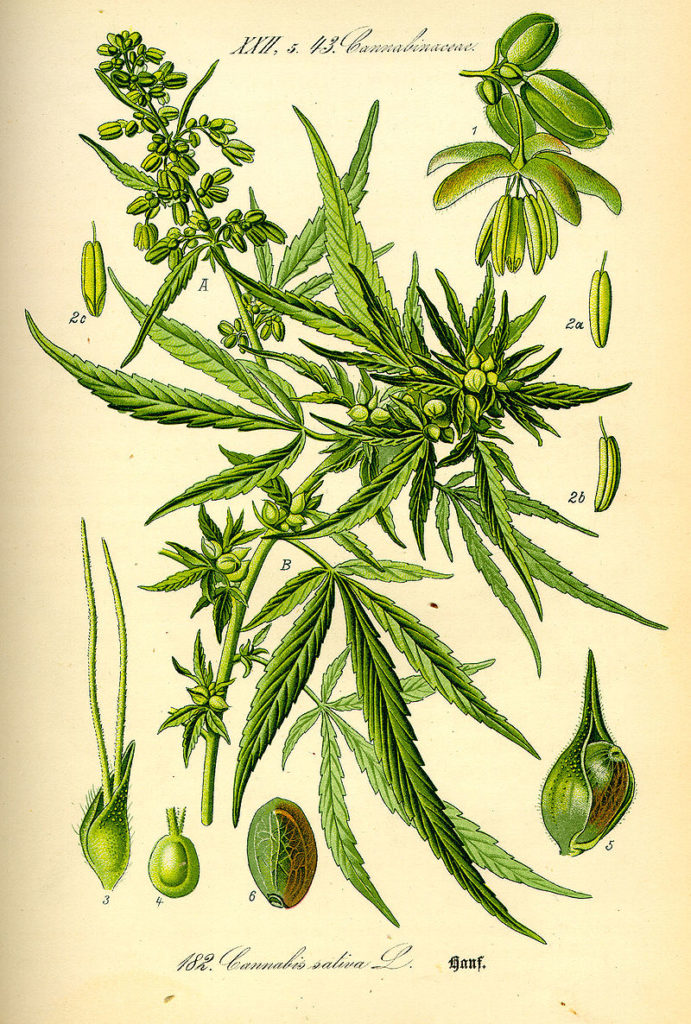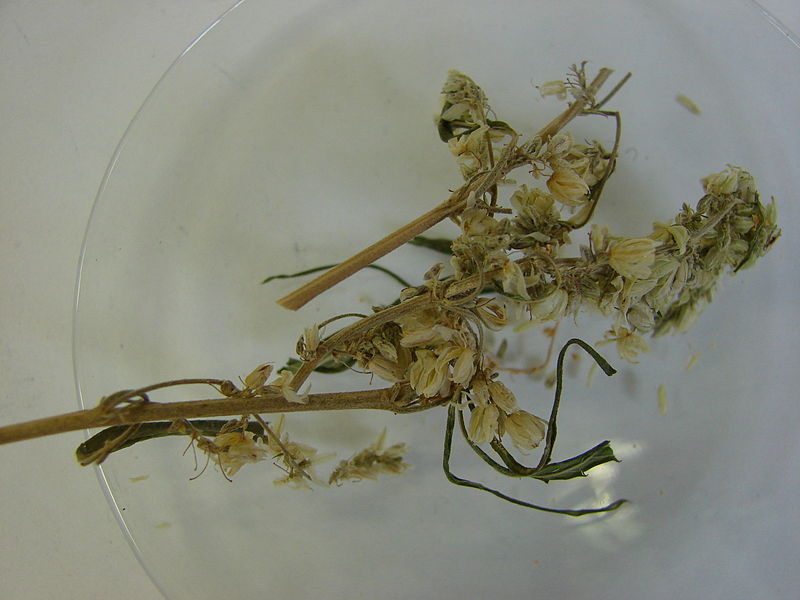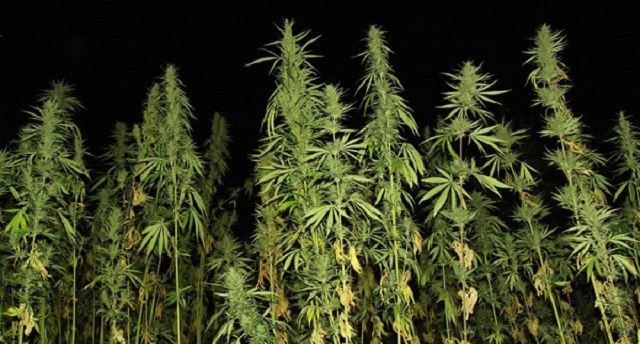January 07, 2019.
The cannabis plant is indigenous to the region of which Afghanistan is a part. Throughout human history, almost every part of the plant has been used – its fibres to make clothes, its oil-rich seeds as a food, its leaves, flowers, and resin as medicine, and of course, as a psychoactive drug. Hashish, made from cannabis resin, is a potent drug. Its production in Afghanistan expanded beyond the country’s traditional markets only in the second half of the twentieth century. In this dispatch, AAN’s Jelena Bjelica and Fabrizio Foschini have collected scarce historical and contemporary literature, reports, studies, intelligence reports and other sources that contain details about the cultural history of cannabis cultivation and hashish production in Afghanistan.
This is the first of two dispatches on the cultural history of hashish in Afghanistan. The second dispatch will look into consumption.
The cannabis plant has been known to humans since the beginning of time. It is a tall annual plant with a hairy stalk and hand-shaped leaves. The species is dioecious, meaning both female and male varieties of the plant exist. The male grows taller, from one to three metres, topped with flowers covered in pollen. The shorter, female plant, with its larger, pollen-catching flowers, produces seeds and protects them with a sticky resin. Cannabis grows almost everywhere and can be seen on the waysides not only in Afghanistan, but also in many other countries. It is characterised by a distinctive, pungent smell.
Hashish, called chars in Dari and Pashto, is made from cannabis plant resin and is usually consumed by smoking, although there are some historical records indicating that it was also consumed in drinks mixed with other substances. Afghanistan’s chars, also known as ‘Afghan Black’, is a potent drug produced in Afghanistan. This dispatch traces the story of Afghan Black through historical records and also offers some general information about the history of hashish. The dispatch will first provide a general history of the cannabis plant, then look at hashish through the historical records of the east (where, according to the historians, its use originates), followed by the historical records in the west, where its use spread during both the nineteenth and twentieth centuries. This dispatch also looks at the expansion of Afghanistan’s hashish production in the 1970s, created by an increase in demand mainly by western travellers, ie hippies, and finally where the country’s production stands today.

Illustration from Otto Wilhelm Thomé’s “Flora from Germany, Austria and Switzerland” 1885 (permission to use under GFDL by Kurt Stueber https://commons.wikimedia.org/wiki/File:Illustration_Cannabis_sativa0.jpg#file)
A short history of the cannabis plant
Russian botanist, Nikolay Ivanovich Vavilov, in his work (published posthumously), The Origin and Geography of Cultivated Plants, points out that although “it is extremely hard to tell when the cultivation of hemp was initiated and what people were instrumental in this,” it is obviously based on the available information that “hemp is a plant of Asia.” (1) Cultivated hemp, the Russian botanist said, originated most probably in the inner-Asiatic centre, an area that comprises north-western India (Kashmir), Pakistan (Punjab and northwest provinces), all of Afghanistan, Tajikistan, Uzbekistan and the western range of Tien-Shan in modern China. Today, both wild and cultivated hemp is present in almost every corner of the world; at least 172 countries across the globe produce their own cannabis primarily to satisfy local demand.
Almost every part of the plant has been used throughout history. The stalks for fibre; the seeds for food and oil; and the flowers, leaves and resin in medical and intoxicating preparations. For example, the United Nation’s Bulletin on Narcotics from 1950 (issue number 4 (2), which looks at the history of cannabis, references the Sanskrit medical work known as Sucruta (sixth or seventh century A.D.) that mentions cannabis as a medicine under the name of b’hanga. “This term occurs in the earlier Atharva Veda (2000-1400 B.C.) and in the work of the celebrated grammarian Pannini,” the bulletin says. The bulletin also references the Kou-Kin-i-Tong, a Chinese treatise on remedies (dating from the beginning of the common era), that mentions the use of a hemp preparation (Ma-Yo) as an anaesthetic in surgical operations. (3) The cultivation and use of hemp for its fibres and medical properties is also well recorded in European and Middle Eastern historical accounts. (4) But even when hemp was first used in Europe, the tribes of eastern and Central Asia had known about cannabis’ psychoactive powers and had been using it for many centuries.
Hashish in the East
There is an accepted view among many authors (5) that the use of cannabis for its psychoactive properties, ie as hashish or chars, originated in Central and South Asia. Vavilov, for example, says (page 117):
The utilization of hemp for hashish did not even require special creative efforts on behalf of Man. When burning stalks and leaves over a wood fire, the humans could certainly not avoid noticing the stupefying effect of the hemp. The quantity of the narcotics substance increase towards sought, where the utilization of hemp for hashish is concentrated.
The 1951 United Nations narcotics bulletin made a similar point: “It has been established beyond dispute,” the bulletin said, “that the use of cannabis to induce a special form of intoxication is of Asian origin.”
“Europe and the Far East have as yet been but slightly contaminated,” it concluded.
The UN narcotics bulletins from the 1950s and most of the 1960s when the UN Commission on Narcotic Drugs, as they said, “has taken great pains in extending the world’s knowledge on cannabis from every point of view: medical, scientific, agricultural, etc” are valuable sources of information. The 1950 bulletin, for example, on the history of cannabis, says that hemp owns the single honour of being sung in the Vedas for its intoxicating properties. But according to the same bulletin: “It was probably the peoples of Northern Iran who discovered those properties, for they were already using the leaves (cheng) and the resin (chers) as inebriants and narcotics before the Hindus.”
In Islamic societies, the consumption of hashish has usually enjoyed an unclear juridical status, especially when compared to alcohol. Religious leaders and rulers have occasionally tried to disincentivise or even prohibit its consumption, but such a ban never enjoyed wide consensus among scholars of Islamic law (see Franz Rosenthal, The Herb: Hashish versus Islamic Medieval Society, Leiden, E. J. Brill, 1971).
The famous Hanbali scholar Ibn Taymiyya (1263-1328), a precursor of modern Salafism, justified the absence of any mention of hashish in the Quran and in the sayings of the Prophet and of the First Caliphs by arguing that the substance had only been imported to Muslim countries at a later stage. According to him, it was the Tartars who came with Genghis Khan’s armies who spread its use among the Muslim population of the countries the Mongols were invading, in order to debilitate their capacity to resist conquest. Ibn Taymiyya was writing at a time when many Muslim states and societies were struggling to survive the Mongols’ onslaught and therefore he may have been biased in his claim, wishing to attribute all the ills of what he perceived as the decadence of the Islamic World to external causes. However, he may have been partially right at least with regards to the provenance of cannabis in the Muslim World, as being the steppes of Central Asia. It is indeed possible that the lords of the steppes, the Turks and Mongols, had inherited cannabis from their predecessors, the Scythians, which they then brought to the cities of Central Asia and Khorasan (the east of the Iranian Plateau covering parts of Afghanistan), where the people engaged in trade and military relations with the nomads. In other writings, Ibn Taymiyya blames the spread of hashish consumption squarely on the Sufis.
In this respect, even the Egyptian historian Al-Maqrizi (1364-1442) recounts a narrative according to which the first to promote the use of cannabis among Muslims was the Sufi sheikh, Qutbuddin Haydar (d.1221). It is unlikely that the use of cannabis was altogether unknown in eastern Muslim countries at such a late stage. Nevertheless, Haydar’s association with an early use of cannabis does seem reasonable, at least in Sufi circles because of the fact that he was based in Khorasan, together with his ‘brand’ of Sufism. Haydar was the founder of the Malamati (blameworthy) Sufi order; these were mystics who despised mainstream piety and lived on the fringes of society. They were not interested in portraying themselves as respectable and thus were often stigmatised. Cannabis was categorised as a ‘low-class’ drug and its use associated with people living on the street or not moving in the higher echelons of society.
This was already apparent in the misleading etymology, which gave rise to an enduring misrepresentation or ‘black legend’ (6) about the Hashishiyya or Assassins, popularised in Europe by Marco Polo and a score of other medieval travellers and chroniclers. ‘Hashishiyya’ was originally meant as a term of common abuse, directed at political adversaries who rebelled against the constituted powers (with the understood meaning of ‘low-life’ or ‘rabble’) to disqualify their status. However, it was recorded by western observers of the time as describing the use of drugs to brainwash the adepts of the Nizari Ismailis (those in possession of Alamut, in modern-day Iran, and several other mountain fortresses across the Middle East and Iranian Plateau) and induce them to commit political murders. Thus was coined a new word adopted by most European languages. (See Daftary, The Assassin Legends: Myths of the Isma’ilis, London, I.B.Tauris, 1994).
As for the effects of cannabis, while many poets and mystics compared its effects, both beneficial and noxious with those of wine, Al-Maqrizi mentions that the original purpose of some Sufis when using cannabis would have been to ‘dry out’ their semen in order to reduce their sexual impulses and thus be able to better concentrate on God. The exact same alleged effects of cannabis would sometimes be employed, from a specular point of view, by orthodox religious leaders trying to deter believers from its use.
Meanwhile, it seems certain that cannabis was being used at this time in what is now Afghanistan (the lack of written sources does not indicate a lack of use). The founder of the Mughal dynasty, Babur (1483–1530), a noted party-goer and collector of intoxicating substances, described the use of majoun, an edible confection made with a mixture of honey, dates, oil, spices and hashish (or sometimes opium), in his autobiography, Baburnama. (7)
Later, western travellers to Afghanistan in the nineteenth and twentieth centuries made frequent references to the use of cannabis. Elphinstone’s Account of the Kingdom of Caubul from 1809 cites the use of bhang – a drink concoction made with hashish, still common in India and Pakistan (the word presumably deriving from the Sanskrit name for cannabis, ‘b’hanga’). Masson, in his Narratives from Various Journeys published in 1842 relays an anecdote involving himself and a group of Afghans who put chits [sic] in the chillum of a Baloch chief who was detaining them to exact a road tax in order to make him fall asleep so they could escape. In Ferrier’s 1858 The History of Afghans, he noted that Afghans frequently smoked chillums, although he shies away from mentioning what they put into it. There are also a number of sources from early twentieth century literature which offer very occasional references to hashish consumption habits in Afghanistan. (See Chapter 7 “Drug Use in Afghanistan’s History” in Macdonald, D., Drugs in Afghanistan, New York, Pluto Press, 2007).
Hashish in the West
In Europe, hashish consumption spread in the nineteenth century. It arrived with Napoleonic soldiers returning from Egypt, who had discovered hashish during their stay there in the late 18th century. Although Napoleon banned both its use and the establishments that sold it in France, the drug would, half a century later, become a source of inspiration for a number of poets and writers. The best-known example is ‘Le Club des Hachichins’ (‘The Club of Hashish Eaters’) in mid-nineteenth century Paris, that held regular meetings at the Hôtel Pimodan on the Seine island of St Louis and included members such as Théophile Gauthier (1811–1872), a French novelist, poet and journalist and famous French poet, Charles Baudelaire (1821–1867). (8)
European poetic glorification of hashish continued during the twentieth century. The famous German-Jewish philosopher, Walter Benjamin, for example, conducted a series of experiments with the drug between 1927 and 1934 in Berlin, Marseilles, and Ibiza, together with a group of friends, including philosopher Ernst Bloch and the writer Jean Selz. (9)
Nonetheless, by the late 1920s, close to 60 countries had prohibited hashish. This was in line with a 1925 revision of the League of Nations’ International Opium Convention from 1912, which came into force in 1928 (see here). Afghanistan became a member of the League of Nations only in 1934, and ratified the 1925 International Opium Convention in 1944 (see here ). Article 11 of the revised Convention said the contracting parties shall undertake:
To prohibit the export of the resin obtained from Indian hemp and the ordinary preparations of which the resin forms the base (such as hashish, esrar, chiras, djamba) to countries which have prohibited their use, and, in cases where export is permitted, to require the production of a special import certificate issued by the Government of the importing country stating that the importation is approved for the purposes specified in the certificate and that the resin or preparations will not be re-exported.
However, the 1925 Convention, in fact imposed only very limited international control. This was mainly because of the ingrained use of hashish in many countries.
After the Second World War, the ‘Beat Generation’ of writers in the 1950s revitalised the image of cannabis in their fiction. This trend continued through the 1960s. (See this research on treatment of drug usage in some examples of modern English writing, published in the 1971 UN Narcotics Bulletin.) The world’s legal regime, however, only became stricter after World War Two. The 1961 United Nation’s Single Convention on Narcotic Drugs prohibited the cultivation of cannabis, listing it alongside cocaine and heroin (see here). (10)
In the 1960s, despite this firmer global legal stance, the use of cannabis (as well as various other drugs) became so popular that they received an approval in popular music (see this excellent study published in the UN Narcotics Bulletin in 1969 about praise for drug usage in rock and roll music here). By in the late 1960s and early 1970s, drug use had increased so significantly that the topic often appeared on the agenda of the Commission on Narcotic Drugs (see bulletins from 1970, 1971 and 1972 here). The hippie generation was in full swing. It would be this generation of hippies that brought the west to the east, as opposed to the merchants and small businessmen who had been doing this in reverse for centuries. (11) The first-ever published Lonely Planet travel guide from 1973, entitled Across Asia on the Cheap summarised this encounter of the west and the east with anecdote:
We rolled up to the Afghanistan border at Islam Q’ala [in Herat province] and could find no sign of officialdom. Eventually we found a group of rather stoned looking Americans sitting on the floor in one building. ‘Where’s everyone?’ we asked, and got the obvious answer ‘gone for lunch’. ‘How long have you been here’ we asked – ‘about six hours’. ‘Good grief what have you been doing all that time?’ – ‘blowing a little dope with customs’. Of course.
On Afghan varieties of the plant
After his explorations in Afghanistan in the mid-1920s, Vavilov concluded that the wild Afghan types of hemp “constitute a morphological link between the wild and cultivated races of hemp” (page 112), meaning that the height of the Afghan cannabis plant, as well as the shape and size of its seeds, represented a link between the wild and cultivated varieties. In 1924, during his travels in the Kunar River valley between Jalalabad in Nangrahar province and Cheghasarai [an old name for Asadabad], the capital of Kunar province, Vavilov discovered a peculiar type of wild hemp with “light-coloured, small seeds, thin membranes, slightly splitting and transparent pericarps.” This variety he named Cannabis Indica, f. [forma] afghanica. He also referred to this wild type when he wrote of “belts of ‘black hemp’ emanating from crops of maize and other cereals,” that grow along the Kunar River “from Chekhosarai to Djelalabad [sic] for a distance of 150 to 200 verst [165 to 220 kilometres]” (page 109).
Whether Vavilov unintentionally fathered the name of what would almost half a century later become known as Afghan Black, the common contemporary name for the Afghan hashish is a subject of historical speculation. Nevertheless, Vavilov’s observations confirmed that farmers who cultivated hemp often collected seeds from wild hemp types to enrich their fields. It is quite possible that this Afghan-specific wild hemp type gradually became cultivated hemp and thus its main product – hashish or chars – became known as ‘Afghan Black’. According to Clarke (1998), this is exactly what happened. He found that the first report of hashish produced from Cannabis Indica, f. [forma] afghanica in northern Afghanistan dates from 1965; asserting an implicit explanation of how Vavilov’s ‘black hemp’ came to be known as ‘Afghan Black’.
Cannabis cultivation and hashish production in Afghanistan
Afghanistan has a tradition of chars (resin) manufacture using sieving techniques probably dating back to the nineteenth century (see here ). Cultivation of cannabis and trade in chars represented a major economic asset for some areas of Afghanistan (Balkh, Khyber and surrounding areas) at the end of the nineteenth and beginning of the twentieth centuries.
Clarke (1988), for example, says that “hashish from Bukhara in Russian Turkestan [present-day Uzbekistan] was considered by Indian users of the early 1800s to be the highest quality available.” The majority of Bukhara hashish was shipped south through Mazar-e Sharif to Kabul in Afghanistan and on to Peshawar in present-day Pakistan. The trade between Russian Turkestan and present-day Pakistan, through Afghanistan, continued through the mid 1860s when Russia extended its territory and influence into Turkestan and changed traditional patterns of hashish production. It is unclear whether Russia officially forbade the production of hashish in Turkestan, but hashish production became less common (Clarke, 1998). In the late 1800s, hashish production shifted from Bukhara (in Uzbekistan) to Yarkand (today’s China). Nevertheless, Afghanistan continued to be an important trade route for the hashish produced in Chinese Turkistan, too.
In fact, until 1934 when the Chinese government issued instructions in a circular to the provinces and municipalities for the suppression of Indian hemp (see this UN Narcotics Bulletin from 1953), Afghans were the main traders between British India (especially the Punjab) and Chinese Turkestan, which was a main producer of chars in the region between the mid 1860s and the 1930s. The route passed from Yarkand and Kashgar through Hunza or through Wakhan. After the Chinese government ban, Afghans gradually started producing their own chars in export quantities.
However, according to the Indian government’s annual reports from 1942 and 1944, mentioned in this 1953 UN Narcotics Bulletin this chars was “heavily adulterated” with tobacco, catechu (an extract from acacia trees) and honey, or it was “garda chars (chars of an inferior quality).” The Indian government’s 1945 report said:
Garda chars. This inferior quality of chars is prepared by various artificial means from the hemp plant growing wild in mountainous regions… Cases of smuggling [it] into the North West Frontier Province and Baluchistan from Gardez in Afghanistan were quite common during the year.
As consumption in British India dwindled towards the late 1940s, so the story of Afghan chars production disappeared from historical records.
 Cannabis flowers (Photo: Maša Sinreih in Valentina Vivod CC BY-SA 3.0 (https://creativecommons.org/licenses/by-sa/3.0) from Wikimedia Commons Cannabis cultivation and hashish production from the 1970s until today
Cannabis flowers (Photo: Maša Sinreih in Valentina Vivod CC BY-SA 3.0 (https://creativecommons.org/licenses/by-sa/3.0) from Wikimedia Commons Cannabis cultivation and hashish production from the 1970s until today
The global legal regime changed after the Second World War and although Afghanistan signed a new convention, the UN Single Convention of Narcotic Drugs in March 1961 and ratified it March 1963, there are very few historical records about cultivation levels in the country in the 1960s. Even after the Single Convention of Narcotic Drugs entered into force in December 1964, Afghanistan reporting to the UN continued to be irregular and erratic.
Nevertheless, according to other sources, during the 1970s production and export of Afghan chars expanded beyond traditional markets. The European Monitoring Centre for Drugs and Drug Addiction study on cannabis production and markets in Europe found that the production of cannabis resin in Afghanistan, as in Nepal and Pakistan, began to change in this decade:
From a cottage industry geared to supplying local and neighbouring long-standing ‘traditional’ markets, it became a commercial enterprise orientated towards large-scale exportation, especially to Europe and North America. As a result, Afghanistan, along with Pakistan and Lebanon, became a major supplier of cannabis resin to Europe for a period of about ten years before the large-scale arrival of Moroccan resin in the early 1980s and the concomitant expansion of European consumer markets.
In 1973, Afghanistan’s King Zahir Shah outlawed cannabis production, following it up with a genuine commitment to eradication – backed by 47 million USD in funding from the United States government. However, a US cable from the same year detailing the involvement of King Zahir’s personal valet in an attempt to smuggle 40 kilogrammes of hashish oil to the US is an illustration of how difficult it was for Afghanistan to start its anti-drug trafficking operations.
Afghanistan’s general cultivation and production levels in the 1970s are matter of guesswork, as the country only occasionally reported to the UN. Cables published by Wikileaks offer some statistical overview of the estimated production which, they say, varied between 150 to 400 metric tonnes between about 1975 and 1979. For example, a US cable on narcotics from November 1977 reported that the year’s production may fall short of the 1976 production estimated at 200 to 400 metric tonnes. The report said that preliminary data showed that in 1977 Paktia province produced 12 metric tonnes; Logar 15 tonnes; Ghazni three tonnes; Samangan 1.5 tonnes; Balkh two tonnes; Jawzjan three tonnes; Faryab 4.5 tonnes and; Badghis 5.5 tonnes. In 1979, the US estimated that the year’s production was at the same level as production in 1976.
There is almost no data about cultivation and production levels in the 1980s. According to Macdonald, the Soviet invasion of Afghanistan meant that areas under cannabis cultivation shifted each year to avoid the ongoing war (Macdonald, pp 193). It also meant that many fields that had been abandoned because most of the local population had become refugees in Pakistan, were now available for growing cannabis. Thus, for example, in parts of Logar land was rented from absent owners by sharecroppers from Sayyed Karam district in Paktia; they greatly expanded cannabis cultivation, expanding it to cover more than 50 per cent of all the agricultural lands of Azra district and up to 80 per cent of those of the Dubandi Valley of Khoshi district. The European Monitoring Centre for Drugs and Drug Addiction study on the supply of hashish to Europe also quoted Howard Marks, a published English drug trafficker, who:
… mentioned how, “the dope supplies in […] Afghanistan had almost dried up when the Russians took their tanks to Kabul in 1980” and how the millions of refugees that ended up in Pakistan’s North West Frontier Province helped develop the production of what became known in the West as “border hash” (Marks, 1998: 249- 250).
The Russian soldiers themselves constituted a prime recipient for Afghanistan’s hashish production: in one of the lanes of Kabul’s Khair Khana neighbourhood, aptly re-named Sarak-e Russ-ha (Russians’ Street), they would engage in petty trade with locals and one of the most sought-after items to barter Red Army supplies for, was chars.
The Taleban regime in the mid-1990s focused on stopping cannabis cultivation and introduced draconian sanctions on cultivators (Macdonald, pp 25, 193). It is difficult to assess how successful these measures were, as there is no data on cannabis cultivation or production levels for the 1990s.
The UNODC first reported on cannabis cultivation well after the fall of the Taleban regime in Afghanistan, in 2005 (see here), when it estimated that around 30,000 hectares were under cannabis cultivation in 22 out of then 32 provinces in the country.
Since 2001, three counter-narcotics laws have been adopted in Afghanistan (see this AAN’s analysis); each of them banned cannabis cultivation and prescribed penalties for it. The first, adopted in 2005, was drafted with the support of the UK, the then-lead donor nation on counter-narcotics. The second law was adopted in 2010 and aimed to address levels of both opium and cannabis cultivation. The most recent revision of the law began in 2015 to address a gap in criminal provisions related to synthetic drugs, the production and consumption of which had become more widespread in the country , and was passed by the Parliament in 2018 (see this AAN analysis). It again criminalised cannabis cultivation and hashish production, trafficking and consumption.
The first detailed estimates of cannabis harvests and hashish production in Afghanistan were carried out in 2009 by UNODC. It reported that between 10,000 and 24,000 hectares of cannabis were grown in Afghanistan every year and estimated that between 1,500 and 3,500 metric tonnes of hashish were produced a year. UNODC also said that in the late 2000s and early 2010s, hashish production declined in Morocco and resumed in both Afghanistan and Lebanon; it reported that Afghanistan was the biggest hashish producer in the world. Nevertheless, this statement has been questioned by some authors and organisations. For example, the European Monitoring Centre for Drugs and Drug Addiction study on the supply of hashish to Europe offers an in-depth analysis of UNODC data and statements. “Moroccan hashish,” concluded its 2011 study, “remained the most consumed resin [on European markets].”
In 2012, UNDOC somewhat changed its methodology and reported that there were 12,000 hectares of mono-cropped commercial cannabis crops that year with a potential production of 1,300 metric tonnes of hashish. The 2012 cannabis survey was the last such survey carried out in Afghanistan. There has been no systematic data on cannabis cultivation or hashish production in Afghanistan since 2012.
Conclusion
Although cannabis is an indigenous plant to Afghanistan and its region, it was not until the late nineteenth/early twentieth century that Afghanistan started producing chars for export mainly to markets in then-British India. Although consumption there dwindled in the late 1940s, the production and export of Afghan chars saw a ‘renaissance’ in the 1970s as its reach expanded beyond traditional markets to Europe. This expansion of the Afghan export market coincided with a general popularisation of hashish in modern culture and popular music, globally – with hippies as a hallmark of it. The hippies were also the bridge between relatively new western cultural narratives on hashish emanating from nineteenth and twentieth century poetry, literature and philosophy and the ancient ones of the east (detailed above).
The name ‘Afghan Black’ may have originated with Russian botanist Vavilov, who, in 1924 named Afghan cannabis the ‘black hemp’ because it grew ‘blackly’ among crops of maize and other cereals. Whether or not it did, it was the hippies who popularised the ‘brand’ of ‘Afghan Black’.
Among Afghans, the use of their own product has increased significantly during the last 40 years of conflict, as will be explored in the second dispatch in this series, which looks at the cultural history of consumption of ‘Afghan Black’ in Afghanistan. It is a rich, contradictory, sometimes poetic and sometimes bitter tale.
Edited by Kate Clark
(1) Nikolay Ivanovich Vavilov, Origin and Geography of Cultivated Plants, Cambridge, Cambridge University Press, 1992
(2) The United Nations’ Commission on Narcotic Drugs and the Economic and Social Council, established in 1946, decided around 1949 “that it would be desirable to disseminate authoritative information” on the subject of narcotics drugs “in a bulletin published by the Secretariat of the United Nations.” The bulletins that have been published between 1949 and 2006 provide a rich and indispensable source of information, available here.
(3) See Mitch Earleywine, Understanding Marijuana: A new look at the scientific evidence, New York, Oxford University Press, 2002. Earleywine refers to a number of references in Chinese and Sanskrit on the use of cannabis for medical purposes, recorded as early as 2737 BC in China and around 1400 BC in India. See also an in-depth analysis for the UN narcotics bulletin in 1965 about the use of opium and cannabis in the traditional systems of medicine in India, by an adviser in indigenous systems of medicine for the Government of India, Shri C. Dwarakanath. He argued in his paper that the traditional use of cannabis in the Ayurvedic and Unani practices should be allowed.
(4) Vavilov, for example, mentions cannabis references by Varro, a Roman author who lived between 127 and 116 BC and authored books on agriculture; Columella, who published a book on agriculture in 65 AD; Pliny the Elder, a Roman scholar (23 to 79 AD) on natural phenomena and; Dioscorides a known physician and herbalist from the first century AD. Vavilov said that Herodotus, the famous Greek historian, mentioned that hemp was not known in ancient Greece before 484 BC Herodotus’ Histories mentions hemp clothing in the land of the Scythian (nomadic people of Iranian origin that inhabited territories north of the Black Sea) and offer an account of a Scythian funeral rite that included inhaling the smoke of cannabis seeds.
(5) See for example: Nikolay Ivanovich Vavilov, Origin and Geography of Cultivated Plants, Cambridge, Cambridge University Press, 1992; Mitch Earleywine, Understanding Marijuana: A new look at the scientific evidence, New York, Oxford University Press, 2002; Robert Connell Clarke, Hashish!, Los Angeles, Red Eye Press, 1998.
(6) In historiography, the term ‘black legend’ refers to what is produced in historical writing by deliberately misreporting on a class of people in order to present them as uniquely inhuman or immoral. It would use false facts or take facts out of context, or exaggerate events to do this.
(7) See also Chapter 7 “Drug Use in Afghanistan’s History” in Macdonald, D., Drugs in Afghanistan, New York, Pluto Press, 2007.
(8) It also included a number of famous French writers like Alexandre Dumas (1802–1870); Honoré Daumier (1808–1879); Honoré de Balzac (1799–1850); Gustave Flaubert (1821–1880) and Victor Hugo (1802–1885) who participated occasionally (see here).
(9) Benjamin’s experiments were inspired by Baudelaire’s writings and life and were documented in his book, published posthumously, entitled On Hashish.
(10) For more details, see also this bulletin from 1962, entitled “The cannabis problem: A note on the problem and the history of international action” which offers a historical overview of the international legal regimes on cannabis . For a historical overview, see this 1966 bulletin published on the occasion of twenty years of narcotics control under the United Nations: For the Commission on Narcotic Drugs’ resolutions and decisions from 1946 until 2014, see here.
(11) See for example this ORF 2 (Austrian TV) documentary from 2016 about the hippie movement, entitled: “Afghanistan on the hippie trail in the 1960s and 1970s – A lost paradise”; (with English subtitles here). See also this documentary from 1977, entitled “Road to Kathmandu” (here).








